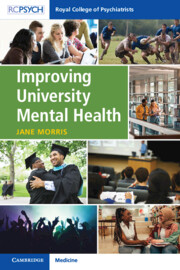Book contents
- Improving University Mental Health
- Improving University Mental Health
- Copyright page
- Contents
- Foreword
- Acknowledgements and Thanks to Contributors
- Chapter 1 Introducing This Handbook
- Chapter 2 Building a New Sense of Belonging
- Chapter 3 The Transition to University for New Students with Pre-Existing Mental Conditions
- Chapter 4 The Roles of Parents and Carers
- Chapter 5 Healthy Bodies, Body Image Concerns, Eating Disorders
- Chapter 6 Alcohol
- Chapter 7 Substance Misuse
- Chapter 8 Social (and Anti-social) Media
- Chapter 9 Finance and Mental Health
- Chapter 10 Neurodiversity
- Chapter 11 Ethnically Diverse University Communities
- Chapter 12 Sexual Behaviour and Gender Identity in Universities
- Chapter 13 The Mental Health of Teaching and Academic Staff
- Chapter 14 An Overview of Mental Disorders in Students and Staff
- Chapter 15 ‘Psychotic’ Disorders
- Chapter 16 Mood Disorders
- Chapter 17 Suicide at University
- Chapter 18 Mental Health Services on Campus and in the NHS
- Chapter 19 Students of the Professions and ‘Fitness to Practise’ Issues
- Chapter 20 Summing It All Up
- Index
- References
Chapter 8 - Social (and Anti-social) Media
Are Universities in Competition with an Invisible ‘Virtual’ Curriculum?
Published online by Cambridge University Press: 08 February 2024
- Improving University Mental Health
- Improving University Mental Health
- Copyright page
- Contents
- Foreword
- Acknowledgements and Thanks to Contributors
- Chapter 1 Introducing This Handbook
- Chapter 2 Building a New Sense of Belonging
- Chapter 3 The Transition to University for New Students with Pre-Existing Mental Conditions
- Chapter 4 The Roles of Parents and Carers
- Chapter 5 Healthy Bodies, Body Image Concerns, Eating Disorders
- Chapter 6 Alcohol
- Chapter 7 Substance Misuse
- Chapter 8 Social (and Anti-social) Media
- Chapter 9 Finance and Mental Health
- Chapter 10 Neurodiversity
- Chapter 11 Ethnically Diverse University Communities
- Chapter 12 Sexual Behaviour and Gender Identity in Universities
- Chapter 13 The Mental Health of Teaching and Academic Staff
- Chapter 14 An Overview of Mental Disorders in Students and Staff
- Chapter 15 ‘Psychotic’ Disorders
- Chapter 16 Mood Disorders
- Chapter 17 Suicide at University
- Chapter 18 Mental Health Services on Campus and in the NHS
- Chapter 19 Students of the Professions and ‘Fitness to Practise’ Issues
- Chapter 20 Summing It All Up
- Index
- References
Summary
Digital technology is ubiquitous in university life. It became indispensable during COVID as a means of delivering teaching and also therapy. University websites and intranets can be valuable repositories of respected health information, signposting and self-help resources, but these need to be kept up to date. There is still a generation gap in terms of being ‘media savvy’ and older people have different experiences online. Society is waking up to the relentless commercial interests driving our online interactions and the psychological conditioning involved. Society needs to protect young brains in particular from exploitation and harm. Long periods spent online mimic psychiatric disorders, by interfering with concentration, causing sleep deprivation, dysregulation, obsessional checking behaviours, body image dysphoria and abnormal interpersonal relations. Unmonitored content and algorithmic amplifications increase distress. Rising rates of deliberate self harm and suicide rates appear to be associated with online experience. Legal and institutional regulation is unlikely to occur without grass roots campaigning. Schools and families usually provides some protection and online safety education. This needs to be reinforced and revisited during the transition to university. Clinicians and others concerned about mental health or wellbeing should explicitly ask questions such as ‘what’s going on for you online?’
Keywords
- Type
- Chapter
- Information
- Improving University Mental Health , pp. 106 - 122Publisher: Cambridge University PressPrint publication year: 2024



